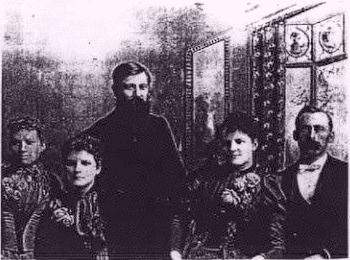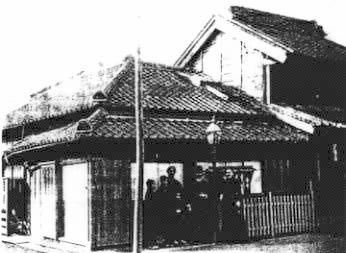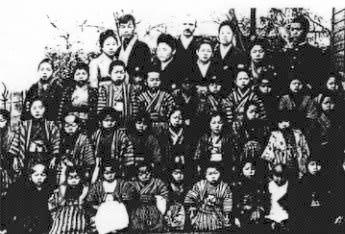Churches of Christ (non-instrument)
One of the remarkable pioneer missionaries of our people in Japan was W.K. Azbill. While Azbill can not be definitely labeled as Disciple or Christian or Church of Christ, he can certainly be identified as the first person to put into practice the principles which developed into the inde pendent or direct support mission method.
One of the remarkable pioneer missionaries of our people in Japan was W.K. Azbill. While Azbill can not be definitely labeled as Disciple or Christian or Church of Christ, he can certainly be identified as the first person to put into practice the principles which developed into the independent or direct support mission method.

Miss Scott, Miss Hostetter, W. K. Azbill, Mr. and Mrs. McCaleb
J.M. McCaleb stayed in Japan 42 years. His autobiography, Once Traveled Roads (1934), is a thoroughly enjoyable story of a man of conviction and principle typical of the early missionaries who came to Japan. It is also the story of a man pretty hard to get along with. He was an autocrat with staying power.
McCaleb believed it was wrong to use instrumental music in worship. He also believed it was wrong to receive support from any organization, even if it was a part of a local congregation. He parted company with his mentor, W.K. Azbill, because Azbill had accepted a pledge of $25 per quarter from a Christian Endeavor Society in an Ohio church.
McCaleb had a plan for training young men by having them in residence in his home in Zoshigaya but ultimately it was not successful. His home still stands in Toshima-Ku (Ward) in Tokyo. That Ward has recently bought the house to preserve it as a cultural monument.
Equally important in early non-instrument history was Eugenese Snodgrass. (Though most documents call him "Eugene" his correct name is as above.) He arrived in the spring of 1888 and was sent to Akita Prefecture by the FCMS. He was not comfortable there for two reasons. One, his passport said that he was in Akita to teach in a mission school which in fact the FCMS had already closed. Snodgrass was too conscientious a person to continue there under false pretenses. Second, he was convinced that the mission headquarters should be located in Tokyo, not in Akita. He was pushing for such a relocation.

Mr. Snodgrass and Miss Penrod with some Japanese Christians in front of ther first meeting place of our people.
After he returned to Tokyo, Snodgrass had a very emotional argument with fellow FCMS missionary, George T. Smith, when Smith attempted to introduce the organ into the worship service. As a result, The FCMS asked them both to resign. The matter was submitted to the Broadway Christian Church, J.W. McGarvey's home church, Lexington, Kentucky. When this church supported the Society's decision, Snodgrass became an independent missionary (1892).
In Tokyo, Snodgrass joined with Loduska J. Wirick and Miss C.T. (?) Penrod to form a Bible chair in the first church of our people in Tokyo. It became the prototype of the Kamitomizaka church. Snodgrass went back to the U.S. in 1893 and returned to Japan for one more term, 1895 - 1903.
As a writer of the "Foreign Missionary Column" in the non-instrument journal, the Gospel Advocate, he became a strong supporter of independent missionary work and a gadfly of missionary organizations. In one of his columns he listed 21 independent missionaries working in Japan in 1895.
Another important missionary in those pioneer days was William Bishop, who served in Japan from 1899 -1913. He was the first one to translate into Japanese J.W. McGarvey's commentary, Acts of the Apostles. Motoyuki Nomura found a couple of copies of this book in an old bookstore and shared one with me. It is a prized possession.

Mr. Snodgrass with the first Sunday School group
O.D. Bixler and E.A. Rhodes in 1919 and the twin brothers, Herman Fox and Harry Robert Fox in 1920 were notable missionaries in the pre-war period. These men were from the premillennial group of about 100 churches based in Louisville, Kentucky. They were moderates, not given to fighting over the millennial issue. Rhodes always maintained his premillenial relationship, but the other three later became associated with the "mainstream" Churches of Christ, numbering about 10,000 churches, centered in Tennessee and Texas. Bixler, Rhodes and Herman Fox settled in Ibaraki Prefecture while Harry Fox settled in Fukushima.
B.D. Morehead served in Japan from 1925-1930. A Tennessee brother named King provided the money and Morehead used it to start King's Bible School in Hitachi-Ohta, Ibaraki with ten students. It was the predecessor of Ibaraki Christian College.
Morehead was a peacemaker, loved by all, but he couldn't get the language. He was persuaded to return to Tennessee and recruit missionaries. This he did. He returned to Nashville and became a one-man missionary society recruiting missionaries from the "mainstream" non-instrumental churches in the south. He is still alive, age 86.
First back after the war was Harry Robert Fox, Sr. He came to Nagasaki in September 1945, working as an interpreter with the commission investigating atomic bomb casualties. He used the occasion to visit the churches and report on their situation. He and O.D. Bixler recruited a hardy group of missionaries mainly from Harding College headed by Pres. George Benson, but also from related churches in the south. This was a switch both for the college and the churches which, until Benson's time, were either anti-missionary or non-missionary in stance.
O.D. Bixler returned to Japan, December 16, 1946 along with twenty representatives of various missionary groups under an arrangement with the Civil Information and Education branch of General MacArthur's headquarters. They brought a shipload of goats and cows to help restore a food supply for a Japan which at that time was living at a near starvation level. Bixler was a strong post-war figure. After his death, his son returned for a time to carry on his work, especially with the church at Ochanomizu.
E.A. Rhodes was also able to come back early as a dependent of his son who was serving in Eighth Army Headquarters, Yokohama.
Churches of Christ had already bought a tract of land froni the Hitachi Conipany in Ibaraki Prefecture. Harry Robert Fox, Jr. and his brother, Logan Fox, together with a group of students mainly from Harding College, settled there. Shion Gakuen was started in 1948, Tandai Junior College and the four-year Ibaraki College in 1951. The Bible chair that was on the campus has now been moved to Mito. The College Church of Christ will also soon have to go, leaving the college mostly in secular hands.
Practically every denominational group in the early days thought that founding educational institutions was one of the best ways to win Japan to Christ. Such institutions have consumed a great portion of the funds committed for evangelizing this country without accomplishing that purpose. Finally these institutions become operated by an administration and faculty which are mostly non-Christian while the Christian influence that remains becomes symbolic. This has happened world-wide.
At the present time, Churches of Christ have 40-45 churches. These are mostly in the area from Shizuoka to Ibaraki with one each in Sapporo, Misawa, Hachinohe, Sendai, Nagoya, Osaka and three in Okinawa. There are 30 ministers, 10 ministerial students, 9 missionaries and a membership of about 1000. The ministers jointly publish a monthly magazine, Fukuin, with a circulation of 700. They have 3 benevolent institutions and 2 summer camp grounds.
Pre-war, non-instrument churches had 33 married missionaries and 16 single missionaries who served in Japan.